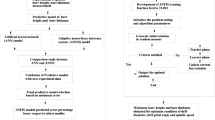Abstract
This paper describes the comparison of the burr size predictive models based on artificial neural networks (ANN) and response surface methodology (RSM). The models were developed based on three-level full factorial design of experiments conducted on AISI 316L stainless steel work material with cutting speed, feed, and point angle as the process parameters. The ANN predictive models of burr height and burr thickness were developed using a multilayer feed forward neural network, trained using an error back propagation learning algorithm (EBPA), which is based on the generalized delta rule. The performance of the developed ANN models were compared with the second-order RSM mathematical models of burr height and thickness. The comparison clearly indicates that the ANN models provide more accurate prediction compared to the RSM models. The details of experimentation, model development, testing, and performance comparison are presented in the paper.
Similar content being viewed by others
References
Gillespie LK (1979) Deburring precision miniature parts. Precis Eng 1(4):189–198
Gillespie LK (1975) Burrs produced by drilling. Bendix Corporation, Unclassified Topical Report, BDX-613-1248
Gillespie LK, Blotter PT (1976) The formation and properties of machining burrs. ASME J Eng Ind 98(2):66–74
Sugawara A, Inagaki K (1982) Effect of workpiece structure on burr formation in micro-drilling. Precis Eng 4(1):9–14
Pande SS, Relekar HP (1986) Investigations on reducing burr formation in drilling. Int J Mach Tool Des Res 26(3):339–348
Stein JM, Dornfeld DA (1997) Burr formation in drilling miniature holes. Ann CIRP 46(1):63–66
Kim J, Dornfeld DA, Furness RJ (1999) Experimental study of burr formation in drilling of intersection holes with gun and twist drills. Trans NAMRI/SME 27:39–44
Dornfeld DA, Kim JS, Dechow H, Hewson J, Chen LJ (1999) Drilling burr formation in titanium alloy, Ti-6Al-4V. Ann CIRP 48(1):73–76
Min S, Dornfeld DA, Nakao Y (2003) Influence of exit surface angle on drilling burr formation. ASME J Manuf Sci Eng 125(4):637–644
Ko S-L, Chang J-E, Kalpakjian S (2003) Development of drill geometry for burr minimization in drilling. Ann CIRP 52(1):45–48
Lin T-R (2002) Cutting behavior of a TiN-coated carbide drill with curved cutting edges during the high-speed machining of stainless steel. J Mater Proces Technol 127:8–16
Lin T-R (2002) Cutting behaviour using variable feed and variable speed when drilling stainless steel with TiN-coated carbide drills. Int J Adv Manuf Technol 19:629–636
Gaitonde VN, Karnik SR, Achyutha BT, Siddeswarappa B (2005) GA applications to RSM based models for burr size reduction in drilling. J Scient Ind Res 64:347–353
Gaitonde VN, Karnik SR, Achyutha BT, Siddeswarappa B (2006) Taguchi approach with multiple performance characteristics for burr size minimization in drilling. J Scient Ind Res 65:977–981
Gaitonde VN, Karnik SR, Achyutha BT, Siddeswarappa B (2007) Methodology of Taguchi optimization for multi-objective drilling problem to minimize burr size. Int J Adv Manuf Technol 34:1–8
Gaitonde VN, Karnik SR, Achyutha BT, Siddeswarappa B, Davim JP (2007) Predicting burr size in drilling of AISI 316L stainless steel using response surface analysis. Int J Mater Prod Technol (in press)
Min S, Kim J, Dornfeld DA (2001) Development of a drilling burr control chart for low alloy steel, AISI 4118. J Mater Process Technol 113:4–9
Kim J, Dornfeld DA (2000) Development of a drilling burr control chart for stainless steel. Trans NAMRI/SME 28:317–322
Kim J, Min S, Dornfeld DA (2001) Optimization and control of drilling burr formation of AISI 304L and AISI 4118 based on drilling burr control charts. Int J Mach Tools Manuf 41:923–936
Guo YB, Dornfeld DA (1998) Finite element analysis of drilling burr minimization with a backup material. Trans NAMRI/SME 26:207–212
Guo YB, Dornfeld DA (2000) Finite element modeling of burr formation process in drilling 304 stainless steel. ASME J Manuf Sci Eng 122(4):612–619
Min S, Dornfeld DA, Kim J, Shyu B (2001) Finite element modeling of burr formation in metal cutting. Mach Sci Technol 5(3):307–322
Kosko B (1994) Neural networks and fuzzy systems. Prentice-Hall of India, New Delhi, India
Schalkoff RB (1997) Artificial neural networks. McGraw-Hill International Edition, New York
Kim DH, Kim DJ, Kim BM (1999) The application of neural networks and statistical methods to process design in metal forming processes. Int J Adv Manuf Technol 15:886–894
Tong KW, Kwong CK, Yu KM (2004) Process optimisation of transfer moulding for electronic packages using artificial neural networks and multiobjective optimisation techniques. Int J Adv Manuf Technol 24:675–685
Özel T, Karpat Y (2005) Predictive modeling of surface roughness and tool wear in hard turning using regression and neural networks. Int J Mach Tools Manuf 45:467–479
Bagci E, Işık B (2006) Investigation of surface roughness in turning unidirectional GFRP composites by using RS methodology and ANN. Int J Adv Manuf Technol 31:10–17
Cochran WG, Cox GM (1992) Experimental designs, 2nd edn. Wiley, New York
Montgomery DC (2003) Design and analysis of experiments. Wiley, New York
MathWorks Inc. (2005) MATLAB user manual version 7.1 R14. MathWorks Inc., Natick, MA
Author information
Authors and Affiliations
Corresponding author
Rights and permissions
About this article
Cite this article
Karnik, S.R., Gaitonde, V.N. & Davim, J.P. A comparative study of the ANN and RSM modeling approaches for predicting burr size in drilling. Int J Adv Manuf Technol 38, 868–883 (2008). https://doi.org/10.1007/s00170-007-1140-7
Received:
Accepted:
Published:
Issue Date:
DOI: https://doi.org/10.1007/s00170-007-1140-7




